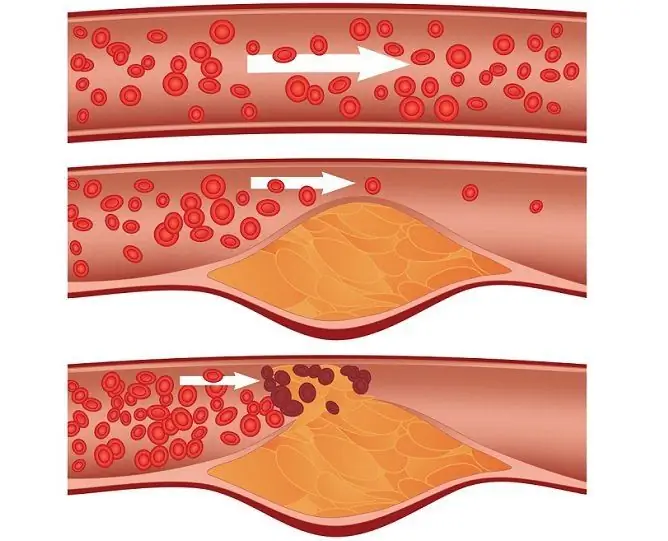- Author Rachel Wainwright [email protected].
- Public 2023-12-15 07:39.
- Last modified 2025-11-02 20:14.
Strabismus in children
The content of the article:
- Forms of the disease
- Causes of strabismus in children and risk factors
- Symptoms
- Diagnostics
- Treatment of strabismus in children
- Possible complications and consequences
- Forecast
- Prevention
Strabismus in children (strabismus, heterotropy) is a constant or periodic deviation of the visual axis of the eye from the fixation point, which causes a violation of binocular vision.
An objective sign of the disease is the asymmetrical position of the corneas in relation to the corners and edges of the eyelids. However, strabismus in children refers not only to cosmetic defects, but also disrupts the functioning of almost all parts of the visual analyzer. The deviation of the position of one or both eyes from the central axis causes the visual axes not to intersect on the fixed object. In the visual centers of the cerebral cortex, monocular images, which are separately perceived by the right and left eyes, do not merge into a single visual image, but a double image of the object appears.
Most often, strabismus is recorded in 2-3% of children under three years old, with the same frequency in boys and girls.
Forms of the disease
Strabismus in children is:
- congenital - manifests itself immediately or during the first six months of life;
- acquired - is formed from six months to three years.
Depending on the stability of the deviation of the eye, it is subdivided into periodic (transient) and permanent.

Source: nazdor.ru
Depending on whether one eye or both is affected, strabismus in children can be unilateral (monolateral) and intermittent (alternating).
According to the severity of strabismus:
- latent, or heterophoria;
- compensated - determined only during an ophthalmological examination;
- subcompensated - manifested only when control is weakened;
- decompensated - uncontrollable.
Depending on the direction of deviation of the affected eye, strabismus in children is classified into horizontal, vertical and mixed.
Horizontal squint, in turn, happens:
- converging - the affected eye is deflected towards the bridge of the nose;
- divergent - the eye is deflected to the temple.
With vertical strabismus, the eye can move upward (supraverged form, hypertropia) or downward (infraverted form, hypotropia).
In addition, strabismus is subdivided into:
- friendly - the movements of the eyeballs in different directions are fully preserved, there is no diplopia, there is a violation of binocular vision;
- unfriendly, or paralytic - the mobility of the eye towards the affected muscle is limited, diplopia and impaired binocular vision are noted.
Concomitant strabismus is classified into:
- accommodative - disappears under conditions of optimal optical correction;
- partially accommodative - with optimal optical correction, the strabismus angle decreases;
- non-accommodating - under conditions of optimal optical correction, the deviation value does not change.
Causes of strabismus in children and risk factors
Pathology can have different causes, that is, it is polyetiological. In some cases, the cause of strabismus in children is the weakness of the eye muscles. The pathological process can develop against the background of a moderate or high degree of myopia (myopia), hyperopia (farsightedness), astigmatism, since when the child's eyesight deteriorates, excessive eye strain occurs. In the case of hyperopia, convergent strabismus usually develops, and in myopia, divergent strabismus in children.
The main causes of congenital strabismus include:
- family predisposition;
- genetic disorders (Cruson's syndrome, Down's syndrome, etc.);
- pathology of the nervous system (cerebral palsy, hydrocephalus);
- congenital eye pathologies (cataracts, etc.);
- premature birth;
- low birth weight;
- taking certain medicines by a pregnant woman;
- smoking and alcohol abuse during pregnancy.
The reasons for the development of the acquired form of strabismus in children are:
- other eye pathologies (atrophy of the optic nerve, inflammation of the choroid, retinal detachment, leukoma, macular degeneration, decrease in the size of the eyeball, iris coloboma);
- paralysis of the abducens, oculomotor nerves;
- excessive visual stress;
- infectious diseases (measles, scarlet fever, diphtheria, influenza, meningitis, encephalitis);
- multiple sclerosis;
- rheumatic diseases;
- neoplasms of the eye;
- craniocerebral trauma, fractures of the wall and bottom of the orbit;
- frequent stressful situations;
- severe fright.
Symptoms
An objective sign of heteropia, regardless of the form of the disease, is the asymmetric position of the pupil and iris relative to the palpebral fissure. Congenital strabismus in children usually appears already in the first days of life.

Source: zrenie.online
With unilateral strabismus in children, there is a decrease in visual acuity of the affected eye and the development of dysbinocular amblyopia. With intermittent strabismus, amblyopia is usually absent, and if it does develop, it is not significantly expressed.
With concomitant strabismus, image doubling, as a rule, does not occur. The volume of movement of the affected and healthy eyes is practically the same, the angles of primary and secondary deviations are equal, and there is no dysfunction of the oculomotor muscles.
In the paralytic form, the mobility of the eye deflected towards the paralyzed muscle is limited or absent. Patients complain of doubling of the image of the object in question, headache and attacks of dizziness, which disappear when one eye is closed. Trying to locate an object is difficult. With paralytic strabismus, the angle of the primary deviation (of the affected eye) is less than the angle of the secondary deviation (of the healthy eye). To compensate for visual impairment, the child is forced to tilt or turn his head, which contributes to the passive transfer of the image of the object to the central fovea of the retina, thus eliminating image doubling.
With the development of strabismus against the background of lesions of the oculomotor nerve, pupil dilation, ptosis (ptosis) of the upper eyelid, deviation of the affected eye downward and outward, partial ophthalmoplegia and accommodation paralysis are usually noted.
Diagnostics
The diagnosis is made on the basis of the characteristic external signs of the disease. In order to identify the form of pathology, complaints and anamnesis are collected, finding out the duration of the pathology, its sudden or gradual development, the relationship with injuries or existing diseases, the course of pregnancy in the mother. During an objective examination, a forced position of the head, asymmetry of the eye slits, face, the position of the eyeballs in the eye sockets (enophthalmos, exophthalmos) are noted. The condition of the fundus, transparent media and anterior parts of the eyes is assessed by examination with lateral illumination, in transmitted light, as well as by ophthalmoscopy.
Visual acuity is determined without correction of eye refraction and with the maximum possible correction. At the same time, the presence of amblyopia, which can serve as both a causal factor in the development of strabismus, and a pathogenetic link of the disease, is evidenced by the absence or slight increase in visual acuity with optimal correction.
The four-point color test has good diagnostic capabilities for assessing the nature of vision (binocular, monocular in one eye, monocular alternating, simultaneous). The study of binocular vision can also be carried out by means of a synoptophore (it is also used to determine the angle of deviation) and non-apparatus methods. When determining the angle of strabismus, the eyes are alternately turned off from the visual act (closed with a hand or a shutter).

Source: blondie.ru
The functions of the oculomotor apparatus are investigated by determining the gaze field, coordimetry. With convergent strabismus in children, hyperadduction is noted, with divergent strabismus, hypoadduction. With concomitant strabismus, the movements of the eyeballs are free in all directions, with paralytic strabismus, they are limited towards the affected muscle, which serves as the main differential diagnostic sign of pathology.
If a paralytic form of strabismus is suspected, it is recommended to consult a neurologist with the performance of electroencephalography, electromyography, electroneurography, etc. Forced tilt of the head in paralytic strabismus in children should be differentiated from that in otitis media and torticollis.
Treatment of strabismus in children
It is recommended to start treating strabismus in children immediately after the diagnosis is made so that the child is sufficiently rehabilitated by the beginning of school.
Conservative therapy for strabismus in children includes correction of visual acuity. So, wearing glasses for myopia or hyperopia sometimes allows you to correct strabismus.
The occlusion method can be used to correct vision. The healthy eye is closed, which over time improves the functionality of the affected eye. Such patients are advised to play with small objects (puzzles, mosaics, construction sets) to normalize the function of the retina. A healthy eye should be opened periodically. Occlusion for strabismus in children is carried out for 2-6 months with periodic, once every 2 weeks, vision control in both eyes. When translating unilateral strabismus into intermittent occlusion, gradually stop.

Source: medknsltant.com
For the treatment of strabismus in children, hardware methods are also used. Infrared laser therapy can improve tissue nutrition, restore the tone of the oculomotor muscles, and eliminate spasms. Magnetotherapy is used for inflammation of the eye tissues, as well as for amblyopia. In complex treatment, a synoptophore is used, which allows you to train the general mobility of the eye and restore binocular vision.
In order to improve the functioning of the eye muscles, a set of eye exercises is selected, which should be performed regularly.
Drug therapy depends on the etiology and clinical picture of the disease. It includes the use of drugs in the form of drops to improve vision, dilate pupils, and relax the eye muscles. Vitamin therapy is indicated.
Surgical treatment of strabismus in children is indicated in the absence of a positive effect from conservative therapy for 1-1.5 years. With a congenital form of strabismus, surgery is recommended for up to three years.
The goal of surgical treatment is to restore the balance of the muscles that move the eyeballs. Surgical intervention allows you to get rid of a cosmetic defect, however, for further correction of violations (including to restore normal binocular vision), a complex of drug and non-drug therapy is used.
Possible complications and consequences
In the absence of correction, strabismus in children in about 50% of cases leads to a decrease in visual acuity and the development of amblyopia. In addition, it has an adverse effect on the child's psyche (contributes to the formation of isolation, irritability, negativism), and further limits the choice of the sphere of professional activity.
Forecast
The most successful is the correction of friendly accommodative strabismus. In the absence of timely and adequate treatment of strabismus in children, vision can be irreversibly reduced. With late diagnosed paralytic strabismus, restoration of full-fledged visual function is not possible.
Prevention
In order to prevent congenital strabismus, any adverse effects on the fetus in the prenatal period of development should be avoided. To prevent the development of acquired strabismus, the following measures are recommended:
- timely optical correction of ametropia;
- regular examinations of the child by an ophthalmologist;
- avoidance of excessive visual stress;
- prevention of injuries;
- avoidance of stressful situations.
YouTube video related to the article:

Anna Aksenova Medical journalist About the author
Education: 2004-2007 "First Kiev Medical College" specialty "Laboratory Diagnostics".
The information is generalized and provided for informational purposes only. At the first sign of illness, see your doctor. Self-medication is hazardous to health!






